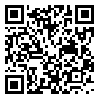Sat, Jun 28, 2025
| فارسی
Volume 25, Issue 4 (Winter 2020)
IJPCP 2020, 25(4): 440-453 |
Back to browse issues page
Download citation:
BibTeX | RIS | EndNote | Medlars | ProCite | Reference Manager | RefWorks
Send citation to:



BibTeX | RIS | EndNote | Medlars | ProCite | Reference Manager | RefWorks
Send citation to:
Lotfi M, Bahrampoori L, Amini M, Fatemitabar R, Birashk B, Shiasi Y. Developing the Persian Version of Positive and Negative Affect Scale for Children (Original and Short Form) and Assessing Its Psychometric Properties. IJPCP 2020; 25 (4) :440-453
URL: http://ijpcp.iums.ac.ir/article-1-2934-en.html
URL: http://ijpcp.iums.ac.ir/article-1-2934-en.html
Mozhgan Lotfi1 

 , Leila Bahrampoori2
, Leila Bahrampoori2 

 , Mahdi Amini3
, Mahdi Amini3 

 , Reyhane Fatemitabar2
, Reyhane Fatemitabar2 

 , Behrooz Birashk4
, Behrooz Birashk4 

 , Yasaman Shiasi5
, Yasaman Shiasi5 




 , Leila Bahrampoori2
, Leila Bahrampoori2 

 , Mahdi Amini3
, Mahdi Amini3 

 , Reyhane Fatemitabar2
, Reyhane Fatemitabar2 

 , Behrooz Birashk4
, Behrooz Birashk4 

 , Yasaman Shiasi5
, Yasaman Shiasi5 


1- Department of Mental Health, School of Behavioral Sciences and Mental Health (Tehran Institute of Psychiatry), Iran University of Medical Sciences, Tehran, Iran.
2- Azad University, Science and Research Branch, Tehran, Iran.
3- Department of Addiction, School of Behavioral Sciences and Mental Health (Tehran Institute of Psychiatry), Iran University of Medical Sciences, Tehran, Iran. ,Amini.mh@iums.ac.ir
4- Department of Clinical Psychology, School of Behavioral Sciences and Mental Health (Tehran Institute of Psychiatry), Iran University of Medical Sciences, Tehran, Iran.
5- Department of Clinical Psychology, University of Social Welfare and Rehabilitation Sciences, Tehran, Iran.
2- Azad University, Science and Research Branch, Tehran, Iran.
3- Department of Addiction, School of Behavioral Sciences and Mental Health (Tehran Institute of Psychiatry), Iran University of Medical Sciences, Tehran, Iran. ,
4- Department of Clinical Psychology, School of Behavioral Sciences and Mental Health (Tehran Institute of Psychiatry), Iran University of Medical Sciences, Tehran, Iran.
5- Department of Clinical Psychology, University of Social Welfare and Rehabilitation Sciences, Tehran, Iran.
Abstract: (5703 Views)
Objectives: This study aimed to develop and validate the Persian version of original and short forms of Positive and Negative Affect Schedule for Children (PANAS-C) and evaluates its psychometric properties.
Methods: The is a cross-sectional study conducted on male and female students of public elementary and secondary schools in Tehran, Iran in the academic year 2017-2018. The samples were 412 students (56.8% female) selected using cluster sampling method. The data collection tools included PANAS-C, Emotion Regulation Questionnaire For Children And Adolescents (ERQ-CA), Children's Depression Inventory (CDI) and Spence Children's Anxiety Scale (SCAS). Data analysis were performed in SPSS v.20 using descriptive and inferential statistics (exploratory factor analysis, Cronbach's alpha and Pearson correlation test).
Results: The factor analysis revealed that the two factors (Positive and Negative Affect) for original and short forms of PANAS-C. Cronbach's alpha for the total items of original and short forms were 0.85 and 0.81, respectively Moreover, the correlation of positive and negative affects with reappraisal and suppression strategies, anxiety disorders (except obsessive-compulsive) and depression was significant (P= 0.01, and 005).
Conclusion: The Persian version of both original and short forms of PANAS-C had good psychometric properties and it can be used for research and evaluation of positive and negative affect in Iranian children and adolescents.
Methods: The is a cross-sectional study conducted on male and female students of public elementary and secondary schools in Tehran, Iran in the academic year 2017-2018. The samples were 412 students (56.8% female) selected using cluster sampling method. The data collection tools included PANAS-C, Emotion Regulation Questionnaire For Children And Adolescents (ERQ-CA), Children's Depression Inventory (CDI) and Spence Children's Anxiety Scale (SCAS). Data analysis were performed in SPSS v.20 using descriptive and inferential statistics (exploratory factor analysis, Cronbach's alpha and Pearson correlation test).
Results: The factor analysis revealed that the two factors (Positive and Negative Affect) for original and short forms of PANAS-C. Cronbach's alpha for the total items of original and short forms were 0.85 and 0.81, respectively Moreover, the correlation of positive and negative affects with reappraisal and suppression strategies, anxiety disorders (except obsessive-compulsive) and depression was significant (P= 0.01, and 005).
Conclusion: The Persian version of both original and short forms of PANAS-C had good psychometric properties and it can be used for research and evaluation of positive and negative affect in Iranian children and adolescents.
Type of Study: Original Research |
Subject:
Psychiatry and Psychology
Received: 2018/10/31 | Accepted: 2019/07/13 | Published: 2020/04/18
Received: 2018/10/31 | Accepted: 2019/07/13 | Published: 2020/04/18
| Rights and permissions | |
 |
This work is licensed under a Creative Commons Attribution-NonCommercial 4.0 International License. |



